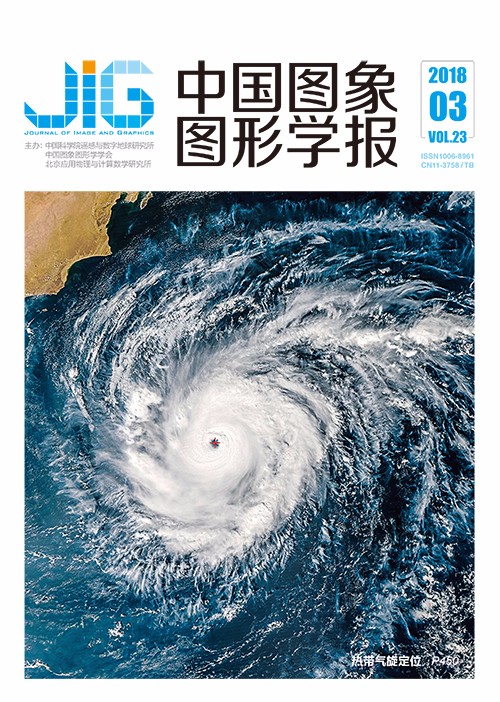
整合神经网络置乱图像的动态自反馈混沌系统图像加密
摘 要
目的 针对当前大多数数字图像加密算法多采用单一的混沌系统,且置乱方法基本只采用像素行列互换、Arnold变换、Baker变换、序列排序构造替换表等几类,提出一种新的整合神经网络置乱图像的动态自反馈混沌系统图像加密算法。方法 该算法通过1维Logistic混沌、chebyshev混沌和自定义m(x)运算构造了一种动态自反馈混沌系统,通过频数检测、序列分布图、平衡度分析、相关性分析、Lyapunov指数验证了系统的随机性,并对其序列进行了均匀化处理,通过序列均匀性证明、序列分布图、序列期望和方差验证了均匀化效果。该算法从混沌序列中随机选取输入值和参数输入神经网络,采用每组神经网络输出值构造置乱矩阵进行初次全局置乱,再从bit位进行二次置乱;采用两组与明文相关的秘钥序列进行像素值替代扩散,使得明文到密文经过中间密文变化,增强了算法的安全性。结果 通过计算机仿真和性能分析表明该加密算法体现了良好的密码学特征,从秘钥空间、秘钥敏感性、统计分析、信息熵、差分分析、相邻像素相关性分析各方面验证了其安全性,数据表明该算法秘钥空间达到了2216,信息熵为7.998 3,水平、垂直、对角方向相邻像素相关系数分别为-0.000 381、0.000 607、-0.000 309,NPCR值介于(0.995~80.996 6)之间,UACI值介于(0.333~0.338)之间。结论 该算法可以实现良好的加密效果,在数据对比上优于超混沌系统图像加密、像素位置和bit位双重置乱加密等,可以被广泛应用在灰度图像加密中乃至扩展到彩色图像加密中,能够起到图像信息在网络传输、存储中的隐私保护作用。
关键词
Dynamic self-feedback chaotic system image encryption based on neural network scrambling image
Luo Haibo, Ge Bin, Wang Jie, Wu Bo(School of Computer Science and Engineering, Anhui University of science and Technology, Huainan 232001, China) Abstract
Objective Several commonalities can be observed among all image encryption algorithms, which are based on a chaotic system. Most secret key generating sources are for the single chaos system, but they lack high randomicity and uniformity. Scramblings only use pixel rank swap, Arnold transform, Baker transform, sequences structure substitution table, and other common methods. The entire encryption process involves one-pixel position scrambling and pixel replacement. This paper proposes a highly secure image encryption algorithm, that is, a dynamic self-feedback chaotic system image encryption algorithm that integrates a neural network scrambling image.Method The algorithm constructs a dynamic self-feedback chaotic system as the secret key generation source. The specific practice is to obtain output using the one-dimensional Logistic chaotic system and the Chebyshev chaotic system through a custom m(x) operation and attain an output value by one-dimensional Logistic chaotic. The formation of the chaotic system by self-feedback is composed of two dynamic subsystems connected in series. The stochastic system is proven by the data of the frequency of detection, sequence distribution, balance analysis, correlation analysis, and Lyapunov index. To achieve sequence homogenization, the processing sequence is continued using the uniform formula, and the homogenization effect is checked through the sequence of uniform proof, sequence distribution, sequence expectation, and variance verification. Second, the algorithm uses a new scrambling method, and neural network is introduced to generate the pixel position scrambling matrix by selecting a neural network input value. Parameters were derived from the dynamic feedback from a group of key sequences generated from a chaotic system. Neural network parameters and input values are changed in the process of Diego generation, and randomization is ensured. The first round is pixel position scrambling, and the second round is position scrambling, which transforms the plain image pixel value into a binary number. The secret key sequence and the corresponding pixel value have the same length. Eight small digital array stores are set through each key. The ranking information is stored by sorting the rearranged array binary number. The number of binary reordering is then converted to a decimal number. The scrambling process is thus completed. Finally, the pixel value substitution process calculates the relevant information of the plain image through the relevant information and the dynamic self-feedback chaotic system. Two groups with the plaintext secret key sequence are generated using a two-pixel group secret key sequence for the two rounds of value instead of the diffusion between the plaintext and ciphertext. A change by intermediate ciphertext has a nonlinear relationship with the complex and ciphertext plaintext, thereby greatly enhancing the security of the algorithm. The two-group key sequences add new key elements in the process of replacement and also expand the secret keyspace.Result Computer simulation and performance analysis show that the encryption algorithm has good cryptographic properties. Security is verified by the secret keyspace, key sensitivity, statistical analysis, information entropy, differences analysis, and correlation analysis of the adjacent pixels. The data show that the algorithm secret keyspace can reach 2216. Information entropy can reach 7.998 3. The vertical and diagonal direction of adjacent pixel correlation coefficients were -0.000 381, 0.000 607, -0.000 309, NPCR value (0.995~80.996 6), and UACI value (0.333~0.338).Conclusion The algorithm can achieve a good encryption effect. The data are better than that of the hyper-chaotic system, double scrambling encryption of pixel position and a bit. The algorithm can be widely used in image encryption and even extended to color image encryption areas. It plays a good role in protecting the privacy of image information transmission and storage in networks.
Keywords
|



 中国图象图形学报 │ 京ICP备05080539号-4 │ 本系统由
中国图象图形学报 │ 京ICP备05080539号-4 │ 本系统由